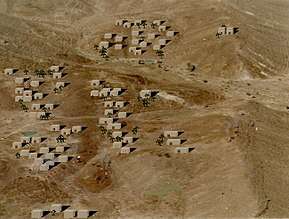List of inventions and discoveries of the Indus Valley Civilisation
.png)
The extent of Indus Valley Civilization.
The list of inventions and discoveries of the Indus Valley Civilization refers to the technological and civilizational achievements of the Indus Valley Civilization, an ancient civilization which flourished in the Bronze Age around the general region of the Indus River and Ghaggar-Hakra River in what is today Pakistan and northwestern India. It is also called the Harappan civilization, after one of its centres, Harappa.
Inventions

- Button, ornamental: Buttons—made from seashell—were used in the Indus Valley Civilization for ornamental purposes by 2000 BCE.[1] Some buttons were carved into geometric shapes and had holes pierced into them so that they could be attached to clothing by using a thread.[1] Ian McNeil (1990) holds that: "The button, in fact, was originally used more as an ornament than as a fastening, the earliest known being found at Mohenjo-daro in the Indus Valley. It is made of a curved shell and about 5000 years old."[2]
- Ruler: The oldest preserved measuring rod is a copper-alloy bar which was found by the German Assyriologist Eckhard Unger while excavating at Nippur (pictured below). The bar dates from c. 2650 BC. and Unger claimed it was used as a measurement standard.[3] Rulers made from Ivory were in use by the Indus Valley Civilization in what today is Pakistan and some parts of Western India prior to 1500 BCE.[4] Excavations at Lothal (2400 BCE) have yielded one such ruler calibrated to about 1/16 of an inch—less than 2 millimeters.[4] Ian Whitelaw (2007) holds that 'The Mohenjo-Daro ruler is divided into units corresponding to 1.32 inches (33.5 mm) and these are marked out in decimal subdivisions with amazing accuracy—to within 0.005 of an inch. Ancient bricks found throughout the region have dimensions that correspond to these units.'[5]
- Stepwell: Earliest clear evidence of the origins of the stepwell is found in the Indus Valley Civilisation's archaeological site at Mohenjo Daro in Pakistan[6] and Dholavira, India.[7] The three features of stepwells in the subcontinent are evident from one particular site, abandoned by 2500 BC, which combines a bathing pool, steps leading down to water, and figures of some religious importance into one structure.[6] The early centuries immediately before the common era saw the Buddhists and the Jains of India adapt the stepwells into their architecture.[6] Both the wells and the form of ritual bathing reached other parts of the world with Buddhism.[6] Rock-cut step wells in the subcontinent date from 200-400 CE.[8] Subsequently, the wells at Dhank (550-625 CE) and stepped ponds at Bhinmal (850-950 CE) were constructed.[8]
See also
References
- 1 2 Hesse, Rayner W. & Hesse (Jr.), Rayner W. (2007). Jewelry making Through History: An Encyclopedia. Greenwood Publishing Group. 35. ISBN 0-313-33507-9.
- ↑ McNeil, Ian (1990). An encyclopedia of the history of technology. Taylor & Francis. 852. ISBN 0-415-01306-2.
- ↑ Scandinavian Archaeometry Center (1993). Archaeology and natural science, p. 118. P. Åströms. Retrieved 9 June 2011.
- 1 2 Whitelaw, page 14
- ↑ Whitelaw, page 15
- 1 2 3 4 Livingston & Beach, 20
- ↑ The Lost River by Michel Danino. Penguin India 2010
- 1 2 Livingston & Beach, page xxiii
This article is issued from
Wikipedia.
The text is licensed under Creative Commons - Attribution - Sharealike.
Additional terms may apply for the media files.